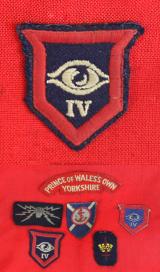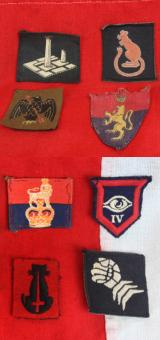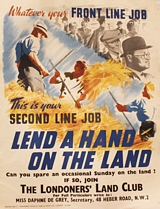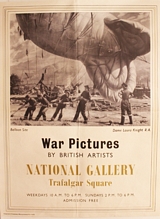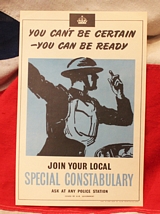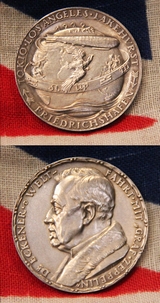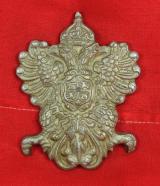Original Uniform Removed British Formation Badges 1939-1945 & King George VIth
An embroidered cloth shoulder title for the Prince of Wales's Own Regiment of Yorkshire, comprising a base of scarlet wool cut in an arc and embroidered on obverse with the title of the regiment "PRINCE OF WALES'S OWN YORKSHIRE" in white thread, and 5 formation badges, including the 4th Guards Armoured. Formation signs were first used by the British Army in WW1 in order to provide an easy method of visual identification of the various units. They were worn on the upper sleeve in pairs, on epaulets, on head gear, painted on unit vehicles, and used on road signs. It was also quickly found that the signs created a morale boosting esprit de corps as each unit became proud of its own symbol. After WW1 the use of formation signs was discontinued, they were reintroduced at the outbreak of WW2.Divisional Signs were reintroduced early in 1940, but instructions were given in 1941 for all formation signs to be referred to as Formation Badges; the official American designation is Shoulder Sleeve Insignia. Formation badges were worn on the sleeves of uniforms except on greatcoats; in battledress, one inch below the regimental or corps shoulder title, and immediately above the arm of service strip. These were narrow two inch strips, introduced in the autumn of 1940, which gave the soldier's arm of service when wearing a steel helmet, or no cap or other distinguishing badges. Infantry battalions wore one, two, or three red strips one below the other, as in the above illustration, to indicate the brigade to which they belonged as shown here.
In tropical kit areas, such as the Middle East and Far East, the formation badges were often worn affixed to the sleeves of Kahki Drill jackets by means of press studs to facilitate laundering, or even worn stitched onto slip-on epaulettes for wearing on the shoulders of K.D, shirts; this was also the method used in the hot summer months in Italy.
On all vehicles, formation badges were stencilled in colour on the forward and rear mudguards, or on the tailboard of trucks; on jeeps the badge appeared on the body below the windscreen on the driver's side.
Officially all formation badges, and other identifying insignia such as regimental titles, were to be removed before going into battle; however, photographic evidence clearly shows that every degree of obedience to this was to be seen in Normandy, and to some extent in Italy, from completely stripped sleeve and vehicle insignia to total disregard of the order. Guards 4th armoured. london district southern commanded
read more
120.00 GBP
Original Uniform Removed 8 British Formation Badges 1939-1945 & King George VIth
Formation signs were first used by the British Army in WW1 in order to provide an easy method of visual identification of the various units. They were worn on the upper sleeve in pairs, on epaulets, on head gear, painted on unit vehicles, and used on road signs. It was also quickly found that the signs created a morale boosting esprit de corps as each unit became proud of its own symbol. After WW1 the use of formation signs was discontinued, they were reintroduced at the outbreak of WW2.Divisional Signs were reintroduced early in 1940, but instructions were given in 1941 for all formation signs to be referred to as Formation Badges; the official American designation is Shoulder Sleeve Insignia. Formation badges were worn on the sleeves of uniforms except on greatcoats; in battledress, one inch below the regimental or corps shoulder title, and immediately above the arm of service strip. These were narrow two inch strips, introduced in the autumn of 1940, which gave the soldier's arm of service when wearing a steel helmet, or no cap or other distinguishing badges. Infantry battalions wore one, two, or three red strips one below the other, as in the above illustration, to indicate the brigade to which they belonged as shown here.
In tropical kit areas, such as the Middle East and Far East, the formation badges were often worn affixed to the sleeves of Kahki Drill jackets by means of press studs to facilitate laundering, or even worn stitched onto slip-on epaulettes for wearing on the shoulders of K.D, shirts; this was also the method used in the hot summer months in Italy.
On all vehicles, formation badges were stencilled in colour on the forward and rear mudguards, or on the tailboard of trucks; on jeeps the badge appeared on the body below the windscreen on the driver's side.
Officially all formation badges, and other identifying insignia such as regimental titles, were to be removed before going into battle; however, photographic evidence clearly shows that every degree of obedience to this was to be seen in Normandy, and to some extent in Italy, from completely stripped sleeve and vehicle insignia to total disregard of the order.
Formation signs were first used by the British Army in WW1 in order to provide an easy method of visual identification of the various units. They were worn on the upper sleeve in pairs, on epaulets, on head gear, painted on unit vehicles, and used on road signs. It was also quickly found that the signs created a morale boosting esprit de corps as each unit became proud of its own symbol. After WW1 the use of formation signs was discontinued, they were reintroduced at the outbreak of WW2.Divisional Signs were reintroduced early in 1940, but instructions were given in 1941 for all formation signs to be referred to as Formation Badges; the official American designation is Shoulder Sleeve Insignia. Formation badges were worn on the sleeves of uniforms except on greatcoats; in battledress, one inch below the regimental or corps shoulder title, and immediately above the arm of service strip. These were narrow two inch strips, introduced in the autumn of 1940, which gave the soldier's arm of service when wearing a steel helmet, or no cap or other distinguishing badges. Infantry battalions wore one, two, or three red strips one below the other, as in the above illustration, to indicate the brigade to which they belonged as shown here.
In tropical kit areas, such as the Middle East and Far East, the formation badges were often worn affixed to the sleeves of Kahki Drill jackets by means of press studs to facilitate laundering, or even worn stitched onto slip-on epaulettes for wearing on the shoulders of K.D, shirts; this was also the method used in the hot summer months in Italy.
On all vehicles, formation badges were stencilled in colour on the forward and rear mudguards, or on the tailboard of trucks; on jeeps the badge appeared on the body below the windscreen on the driver's side.
Officially all formation badges, and other identifying insignia such as regimental titles, were to be removed before going into battle; however, photographic evidence clearly shows that every degree of obedience to this was to be seen in Normandy, and to some extent in Italy, from completely stripped sleeve and vehicle insignia to total disregard of the order.
7th Armoured Division The best known of all armoured divisions, The Desert Rats. It was formed in Egypt in 1938 as a Mobile Division. In December 1939 it became known as the 7th Armoured Division and its commander, Major-General O'Moore Creagh, adopted the jerboa (the desert rat) divisional sign. 6th Armoured Division(1950) Black cat on red ground with red sword = 56th (london) Armoured Division read more
135.00 GBP
An Original King George VIth Fire Service Recruitment Poster By Fosh and Cross
In the first.22 nights of air raids, from Sept 1940, firefighters fought nearly 10,000 fires.
Bombings often occurring while the River Thames was at low tide meaning access to water was made even more difficult. Vehicles became vital in transporting water around the city. Steel frames were fitted to lorries to enable them to carry up to 1,000 gallons of water. Meanwhile, to reduce the workload of the fire service, small fires were dealt with by 'street fire parties' – civilians who were given and taught to use stirrup pumps.
The public's opinion of the fire service changed significantly as a result of the Blitz. During the 'phoney war', firefighters had been thought of as 'army dodgers'. But, in 1940 this attitude changed – our firefighters became known as 'the heroes with grimy faces'. Two days into the Blitz - Churchill told the House of Commons that Adolf Hitler 'hopes by killing large numbers of civilians, that he will terrorise and cow the people of this mighty imperial city... Little does he know the spirit of the British people.'
The Auxiliary Fire Service
As the political climate intensified in Europe during the late 1930s, an Act of Parliament was passed to authorise the formation of a voluntary fire service. The Auxiliary Fire Service (AFS) formed in January 1938 and fire stations were set up in schools, garages and factories.
A recruitment drive was launched, with over 28,000 firefighters needed to support the Brigade's 2,500 officers and firefighters. However, as most young men had joined the army, the AFS welcomed those too old or too young to go to war. It also marked the first time women joined the Brigade.
Did women fight fires in WWII?
Though women did train, they didn't actually fight fires in the Second World War. They became fire watchers and drivers, and managed the communications networks. A rank system for women of the fire service was developed during the war to recognise their service and bravery – many were awarded for their remarkable achievements.
By 1943 over
70,000 women
had enrolled in the NFS in the United Kingdom. When peace was declared, London's fire service had attended over 50,000 calls though tragically, 327 of London's firefighters lost their lives. It's a sacrifice we'll never forget.
We never normally comment on the investment potential of any collectable, but the potential for all underpriced WW1, WW2 etc. posters may be incredible, for example the more famed original poster, 'Keep Calm and Carry On' can now sell for over £20,000.
Good condition 15 inches x 19.75 inches read more
295.00 GBP
A Superb, Large, Soviet Russian Cold War Period Issue Propaganda Poster
Showing photos of famous figures and events in the Russian revolutionary communist party. Vintage or antique Russian posters, in fact all forms of posters, are now becoming extraordinarily collectable. Their original purpose of being entirely transitory and disposable means so few original examples now exist, and can now only be usually seen in museum archive displays. Another poster for the Battleship Potemkin Russian movie, designed by the Stenberg brothers in 1925, sold in November 2012 for 103,250 Pounds Sterling at Christies Auction in London. It arranged class elements into a powerful design of revolutionary upheaval. As with any art form the value of a poster is somewhat dependent on the artist who created it. For example, the Frenchman, Chenet’s work is very sought after, however other artists' work can be even more desirable. Henri deToulouse-Lautrec is well known for his images of the Parisian night-life. His posters are filled with images of showgirls, bright colours, and stylized fonts. The auction record for an art poster is held by his Moulin Rouge, which sold for an amazing $241,500.00 in 1999. Slight staining, creases and small tears mostly bottom left, mounting circular holes to the top section. 57 cm x 86cm.
read more
155.00 GBP
Original WW2 Volunteer Recruitment Poster. 'Lend A Hand On The Land'
A very fine propaganda recruitment poster for the Land Army. Britain re-created the World War I Ministry of Information for the duration of World War II to generate propaganda to influence the population towards support for the war effort. A wide range of media was employed aimed at local and overseas audiences. Traditional forms such as newspapers and posters were joined by new media including cinema (film), newsreels and radio. A wide range of themes were addressed, fostering hostility to the enemy, support for allies, and specific pro war projects such as conserving metal and growing vegetables. In 1940 in particular, Winston Churchill made many calls for the British to fight on, and for British units to fight until they died rather than submit. His calls for fight to victory inspired a hardening of public opinion. Determination raised the numbers of the Home Guard and inspired a willingness to fight to the last ditch, in a manner rather similar to Japanese determination, and the slogan "You can always take one with you" was used in the grimmest times of the war. British victories were announced to the public for morale purposes, and broadcast to Germany for purposes of undermining morale.
Even during Dunkirk, an optimistic spin was put on how the soldiers were eager to return.
When the U-boat commander Gunther Prien vanished with his submarine U-47, Churchill personally informed the House of Commons, and radio broadcasts to Germany asked, "Where is Prien?" until Germany was forced to acknowledge his loss.
The turn of the war made BBC's war commentaries much more stirring.
We never normally comment of the investment potential of any collectable, but the potential for all underpriced WW1 and WW2 posters must be incredible, for example the more famed poster, 'Keep Calm and Carry On' can now sell for over £20,000. This poster is "14.75 x 19.5 inches read more
395.00 GBP
WW2 Advertising Poster for The National Gallery 'War Pictures'
Printed for H.M.Stationary Office by Hubners Ltd. On their way to the Myra Hess concerts in October 1939, visitors to the National Gallery couldn't help noticing the forlorn bare walls where the paintings had been before the war.
Art under fire
Before long, a series of temporary exhibitions was organised a rarity for museums and galleries at the time. There were also rolling displays of contemporary war art organised by the WAAC (War Artists Advisory Committee) that Kenneth Clark had helped set up at the outset of war. The temporary exhibitions spanned a large variety of subjects, ranging from Nineteenth Century French Paintings? and British Painting since Whistler to War Pictures By British Artists and Greater London: Towards a Master Plan.
These exhibitions were often disrupted by the damage inflicted by the nightly bombing raids during the Blitz. This didn't affect the large number of visitors attending. In fact there was much debate as to whether visitors should be asked to leave during the many air-raid warnings that occurred each day. By 1942 the bombing raids had lessened. It was now felt that one painting could be brought up to London from Manod every month. It was put on show in splendid isolation with some accompanying documentary material.
Every night the work was removed from display and stored in the underground strong room for safety. The arrival of each painting was a news event. The picture of the month scheme exists in the Gallery to this day.
Posters are a true form of art with a purpose as they were designed to deliver a particular message through striking designs. These original vintage posters were created to grab the attention of passers-by, presenting artists with the challenge of condensing the message or a concept into a precise, short visual and written form in a single artwork. They are important items of social history that capture the essence of the time they were printed. Original vintage posters are recognised as a sound art investment that can be enjoyed every day. 25 x 18.5 inches read more
295.00 GBP
An Original WW2 British Special Constabulary Recruitment Poster
Published for HMG by Fosh and Cross Ltd London. A propaganda information and recruitment poster. The size as were used in the underground trains advertising panels, or the back of black cabs. Britain re-created the World War I Ministry of Information for the duration of World War II to generate propaganda to influence the population towards support for the war effort. A wide range of media was employed aimed at local and overseas audiences. Traditional forms such as newspapers and posters were joined by new media including cinema (film), newsreels and radio. A wide range of themes were addressed, fostering hostility to the enemy, support for allies, and specific pro war projects such as conserving metal and growing vegetables. In 1940 in particular, Winston Churchill made many calls for the British to fight on, and for British units to fight until they died rather than submit. His calls for fight to victory inspired a hardening of public opinion. Determination raised the numbers of the Home Guard and inspired a willingness to fight to the last ditch, in a manner rather similar to Japanese determination, and the slogan "You can always take one with you" was used in the grimmest times of the war. British victories were announced to the public for morale purposes, and broadcast to Germany for purposes of undermining morale.
Even during Dunkirk, an optimistic spin was put on how the soldiers were eager to return.
When the U-boat commander Gunther Prien vanished with his submarine U-47, Churchill personally informed the House of Commons, and radio broadcasts to Germany asked, "Where is Prien?" until Germany was forced to acknowledge his loss.
The turn of the war made BBC's war commentaries much more stirring.
We never normally comment on the investment potential of any collectable, but the potential for all underpriced WW1 and WW2 posters must be incredible, for example the more famed poster, 'Keep Calm and Carry On' can now sell for over £20,000.
Good condition 14.5 inches x 9.5 inches read more
295.00 GBP
A Rare Karl Goetz Silver Zeppelin World Circumnavigation Medal of 1929
A Rare Karl Goetz Zeppelin Medal. Silver medal of 1929, for circumnavigation of the world, in the airship LZ 127. Half-length portrait of the air pioneer and airship leader Hugo Eckener. Aircraft and flying eagle in front of globe, around the globe a band with star signs. With a punch: BAYER. MAIN COIN OFFICE ? FINE SILVER. 59.98 mm; 54.37 g. Matt finish, very pretty patina, small edge error, almost uncirculated read more
425.00 GBP
A Large 19th century European, Imperial, Crowned, Twin Headed Royal Eagle Crest Mount
In hard metal, probably solid nickel. A most attractive piece that could beautifully embellish either a fine box, door, cabinet, case, or maybe a bespoke wooden plaque. 225 grams, 3.5 inches x 4.5 inches read more
225.00 GBP
A Unique 'Sealed Pattern' Cap Badge of the Fusilier Brigade 16.9 1966
Inspectorate of Stores and Clothing . Since the early XVIII Century, it was common practice for all European armies to approve items of clothing and accoutrements for each regiment in a formal session of the appropriate War Office `Dress Committee`.
At these sessions, an example of each item would be deposited with the Committee, signed, sealed and certified as being the `Sealed Pattern`, against which all items worn in future would be compared. At future inspections of each regiment, any item showing variations from the norm would be amended or scrapped. since the start of the eighteenth century a band of officers of the British Army (or other responsible persons) has approved the quality and finish of all items of military clothing, it was then sealed with the wax of the Board of Ordnance or other Government seal to be recognised as the standard to be kept by the manufacturers. There is valuable evidence to be seen on these patterns because they also carry the date of approval and obsolescence of each item. Unfortunately, that system has not proved to be infallible. In 1841, all sealed patterns accumulated since the beginning of the eighteenth century, were destroyed in a fire at the Tower of London. No secondary store existed and thus all patterns encompassing Marlborough?s campaigns, the Seven Years War, the American War of Independence and the Napoleonic Wars were lost. read more
195.00 GBP


